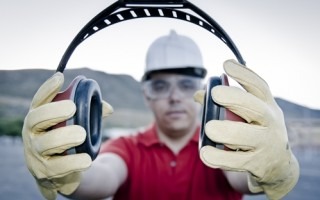
Noise at Work and Home: Put a Plug in the Noise
 Our hearing is precious to us. Once we diminish or lose our hearing we can never fully recover it. Both on the job and at home there are many ways to be overexposed to sounds that can damage our hearing. It is important to realize how loud is too loud and how to protect yourself.
Our hearing is precious to us. Once we diminish or lose our hearing we can never fully recover it. Both on the job and at home there are many ways to be overexposed to sounds that can damage our hearing. It is important to realize how loud is too loud and how to protect yourself.
At Work
Many tools, equipment, and processes in the workplace generate high levels of noise that will have a negative effect on the hearing of the exposed workers. Over 22 million workers are exposed to hazardous noise levels at work each year. Occupational hearing loss is one of the most common workplace injuries today. Damage to our hearing can happen over a short time or over a longer extended period of time depending on the source of the sound. Short loud bursts of noise such as explosions or gun shots can damage our ears in a short time of being exposed. Less hazardous noise such as woodworking equipment, heavy equipment, and machinery can lead to damage over an extended amount of time being exposed to the noise.
At Home
While many people are overexposed at work, there are also many who are overexposed at home. Many of your hobbies may also be causing hearing loss. Activities such as listening to loud music, shooting guns, woodworking, using a lawn mower, riding a dirt bike, etc. will damage your hearing overtime. It is important to understand what levels of noise will damage your hearing.
What is Too Loud?
It is recommended to stay under levels of 85 decibels over an 8-hour time weighted average (TWA).
Here are the average decibel ratings of some familiar sounds:
- Normal conversation- 60 decibels
- Heavy city traffic-85 decibels
- Motorcycles-95 decibels
- Circular saw-100-105 decibels
- An MP3 player at maximum volume-105 decibels
- Sirens- 120 decibels
- Firecrackers and firearms- 150 decibels
Hearing Damage Prevention
The best way to protect yourself is to eliminate the exposure. That can be achieved through removing yourself from the area the noise is in or eliminating the excessive noise altogether.
Engineering controls are the second best choice in protection from noise. Sound barriers, enclosures, and noise dampening systems are examples of engineering controls that will bring down the level of noise in an area.
Administrative controls on using hearing protection, job rotation, breaks, and routine maintenance programs of equipment are some ways that protect workers from being exposed to hazardous noise.
PPE is the last line of defense. It is important to know the levels of noise that remain after applying the other techniques mentioned above. For noises between 85 decibels and 100 decibels on an 8 hour TWA, ear plugs will be enough to protect you if worn correctly. Over 100 decibels then double hearing protection is needed, an example is earplugs and ear muffs. Your distance from the source of the sound and the length of time you are exposed to the sound are also important factors in protecting your hearing. A good rule of thumb is to avoid sounds that are too loud, too close, or last too long.
Summary
Protect your hearing. Once it goes, its gone. It is possible to regain some of your hearing back artificially through hearing aids, but it will never be the same as it was before it was damaged. Take hearing protection seriously. Put a plug in noise!